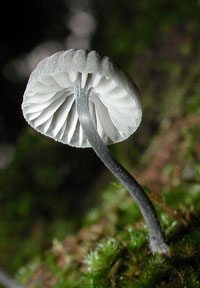
© JJ Wuilbaut |
Mycena
includes a great number of species of which quite
a few have very specific habitat demands. Many of
them have beautiful colours and they show a great
variation in microscopic structures. Being so small,
however, (the pileus diameter rarely exceeding 5 cm)
the Mycena species have not attracted too
many mycologists. Although some of the most skilled
mycologists have been working with the genus, which
resulted in two large monographs (R. Kühner,
1938 and A. H. Smith, 1947), it was not until R. A.
Maas Geesteranus started his revision of the genus
in the 1980's, that a grewing interest could be observed
among Europaen mycologists.
Many new species have been proposed
the recent years, both by Maas Geesteranus as well
as by other mycologists. Probably there are many left
to be described. Maas Geesteranus published a conspectus
with identfication keys and descriptions, which is
an indispensable tool for identifying Mycenas
today. However, many new species have been discovered
after he had terminated his work. There is need for
a new compilation. This site, however, will only deal
with the North European species. |
Generic
characters
-
Habit mycenoid or omphaloid, more rarely
collybioid
-
Pileus glabrous, granular, floccose,
puberulous, or pruinose, sometimes covered with a gelatinous,
sparable pellicle
-
Lamellae ascending, horizontal or arcuate,
almost free or narrowly adnate to decurrent
-
Stipe fragile to cartilaginous or elastic-tough,
in part or entirely pruinose or puberulous, or glabrous,
sometimes dilated below to form a basal disc, often
basally covered with long, coarse fibrils
-
Basidia 2- or 4-spored
-
Spores
usually pip-shaped, less frequently almost cylindrical
or spherical, generally amyloid, more rarely non-amyloid
-
Cheilocystidia clavate, obpyriform,
fusiform, lageniform or, more rarely, cylindrical, smooth
, branched or with variously shaped, simple
or branched excrescences
-
Pleurocystidia numerous, scarce or absent
-
Hyphae of the pileipellis diverticulate,
less frequently smooth
-
Hyphae of the cortical layer of the
stipe smooth or diverticulate, sometimes with terminal
cells or caulocystidia
-
Lamellar trama staining vinaceous to
purplish brown in Melzer's reagent, in a few cases remaining
unaltered
Go to Diagnostic
characters |